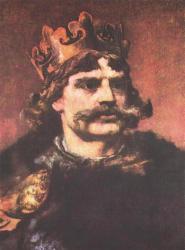
Born: 966 or 967
Died: 1025
The early days. Father (probably) Mieszko I Prince of Poland ; mother – the Czech princess Dubrawka
Marriages.
In 984 Boleslaus married Rikdaga, the daughter of Riddag (Rikdag, Ricdag), the margrave of Meissen (Misnia). This marriage was later dissolved. She was followed by Judith, the daughter of Geza the Great, Prince of Hungary; then Emnilda, the daughter of Dobromir, a Lusatian prince. Emnilda was considered his favorite wife and she was the only one able to control his violent temper. Finally came Oda, daughter of the margrave of Meissen.
Children.His wives bore him sons including Bezprym, Mieszko II – his successor - and Otton; and a daughter, Mathilde. In his will, Mieszko I divided his estate between all his sons, the numbers are not certain. However, only Boleslaus was given the power of the State when he died. As a Prince of Poland, he expelled Oda and his half-brother (her son) from Poland and seized the territories left to his two brothers under their father’s will,.
Consolidation of power.
In 997 Boleslaus sent St. Adalbert of Prague to Prussia on the Baltic Sea to attempt to convert the Prussians to Christianity. In 990 he incorporated Silesia (Slask). By this time he already possessed Pomerania (Pomorze) with its main city of Gdansk, Little Poland (Malopolska) with its main city of Cracow, Slovakia and Moravia. He was on his way to unite all West Slavic countries in one strong, country, member of Christian Europe.
Meeting Otto III - the Emperor.
In A.D. 1000, while on a pilgrimage to the tomb of St. Adalbert at Gniezno, the Holy Roman Emperor Otto III invested Boleslaus with the title Frater et Cooperator Imperii ("Brother and Partner of the Empire"). Some historians say that the emperor also pledged the king's crown to Boleslaus. On the same visit Otto III raised Gnesen (Gniezno) to the rank of an archbishopric.
Coronation.
The emperor Henry II obliged Boleslaus to give a pledge of allegiance again for the lands he held in fief. After Henry died (1024), Boleslaus crowned himself king, rising Poland to a rank of kingdom. Son of Boleslaus, Mieszko II crowned himself immediately after his father death.
Boleslaus send an army to aid his friend Canute the Great, King of Denmark (son of Boleslaus’ sister Sygryda Swietoslawa and of Sven King of Denmark), in his conquest of England.
Boleslaus was the first Polish King, since during his rule Poland became a Kingdom, despite the fact that some of the Polish rulers before 1295 never received a crown. He was the first Polish ruler baptized at birth, the first real Christian ruler. He founded the independent Polish province of the church and made Poland a strong power in Europe. Boleslaus for the first time unified all the provinces that subsequently were considered to comprise Poland: Great Poland, Little Poland, Masovia, Silesia and Pomerania For the Sorbs of Lusatia (Luzyce)he became the national hero.
Boleslaus ranks among Poland’s foremost rulers; he reorganized the administration, systematized taxation, and created a large standing army. Shortly before his death he was crowned king with the approval of the Holy See. He was succeeded by his son, Mieszko II.
This article uses, among others, material from the Wikipedia article "Boleslaus I of Poland" licensed under the GNU Free Documentation License. :
Wikipedia
and other sources
Columbia Encyclopedia
Nationmaster Encyclopedia
Return to home page:
Prominent Poles